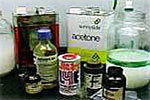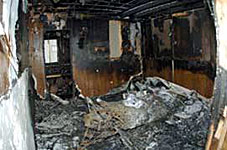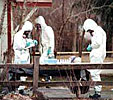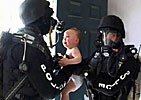Meth Information and Frequently Asked Questions
FAQ
- What is meth?
- Why do people choose meth over other illegal drugs?
- Who is using meth?
- How prevalent is meth abuse?
- Where are meth labs found?
- What does a meth lab look like?
- What risk does meth pose to the environment?
- What are the short-term effects of meth use?
- What are the behavioral impacts of using meth?
- What are the long-term effects of meth use?
- What are withdrawal symptoms of meth?
- What effect does meth have on communities?
- What happens to babies who are born to meth addicted mothers?
- How can I get involved in fighting meth in my community?
By The Numbers
- 12 million
The number of Americans ages 12 and older who reported trying meth at least once during their lifetimes in 2004. (National Survey on Drug Use and Health, ONDCP) - 66,502
The number of meth treatment admissions in 2000. That is up from 14,496 admissions in 1992. (ONDCP Drug Policy Information Clearinghouse Fact Sheet) - 17,170
The number of meth lab busts in 2004. (DEA Briefs and Backgrounds) - 58
The percentage of counties that reported methamphetamine as their greatest drug problem (2005 National Association of Counties survey) - 47
The number of states that reported meth lab incidents in 2004. (DEA Briefs and Backgrounds) - 6.2
The percentage of high school seniors who reported lifetime use of methamphetamine in 2004. (2004 Monitoring the Future Study, National Institute on Drug Abuse)
- What is meth?
-
 Methamphetamine is a synthetic stimulant that is produced and sold illegally in pill form, capsules, powder, and chunks. Two types of meth are crank and ice. Crank refers to any form of methamphetamine. Ice is a crystallized smokeable chunk form of meth that produces a more intense reaction than cocaine or speed. Ice has an appearance that is clear and crystal-like, and resembles frozen ice water. Methamphetamine stimulates the central nervous system and the effects may last anywhere from 8 to 24 hours. Crank and ice are extremely addictive and produce a severe craving for the drug.
Methamphetamine is a synthetic stimulant that is produced and sold illegally in pill form, capsules, powder, and chunks. Two types of meth are crank and ice. Crank refers to any form of methamphetamine. Ice is a crystallized smokeable chunk form of meth that produces a more intense reaction than cocaine or speed. Ice has an appearance that is clear and crystal-like, and resembles frozen ice water. Methamphetamine stimulates the central nervous system and the effects may last anywhere from 8 to 24 hours. Crank and ice are extremely addictive and produce a severe craving for the drug. - Why do people choose meth over other illegal drugs?
-
 There are many reasons why people may choose to use meth. One of those reasons is that it is easy to make. The recipe to manufacture the drug can be obtained over the Internet, and many of the ingredients are common household products such as over-the-counter cold and allergy medicines, iodine, ammonia, starter fluid, drain cleaner, and rubbing alcohol. Meth is also cheaper than many other illegal drugs, such as cocaine and heroin.
There are many reasons why people may choose to use meth. One of those reasons is that it is easy to make. The recipe to manufacture the drug can be obtained over the Internet, and many of the ingredients are common household products such as over-the-counter cold and allergy medicines, iodine, ammonia, starter fluid, drain cleaner, and rubbing alcohol. Meth is also cheaper than many other illegal drugs, such as cocaine and heroin. - Who is using meth?
- Meth abuse is concentrated in the western, southwestern, and midwestern United States, but it is quickly spreading eastward . According to the 2003 National Survey on Drug Use and Health, approximately 12.3 million Americans ages 12 and older reported trying methamphetamine at least once during their lifetimes, representing 5.2% of the population ages 12 and older. According to the National Association of Counties, meth users are generally high school and college age students, white and blue collar workers, and the unemployed in the age ranges between 20s and 30s in rural and emerging urban areas. Meth use is equally divided between males and females, and although use is increasing in Hispanic and Native American communities, it has largely been confined to majority white communities.
- How prevalent is meth abuse?
-
 In 2004, 47 states reported meth lab incidents, including lab, dumpsites, and chemical and glassware seizures. Nationwide, seizures of meth labs have significantly increased, from 7,438 labs in 1999 to 17,170 labs in 2004.
In 2004, 47 states reported meth lab incidents, including lab, dumpsites, and chemical and glassware seizures. Nationwide, seizures of meth labs have significantly increased, from 7,438 labs in 1999 to 17,170 labs in 2004. - Where are meth labs found?
- The Drug Enforcement Agency (DEA) estimates that more than 68% of all meth labs are located in ordinary homes in rural and residential areas, making these labs very difficult for police to detect.
- What does a meth lab look like?
- Meth labs may be set up virtually anywhere, including in homes, campgrounds, rest areas, motel rooms, cars, garages, storage sheds, barns, and vacant buildings. A typical meth lab is a collection of chemical bottles, hoses and pressurized cylinders. Labs are frequently abandoned, and potentially explosive because very toxic chemicals are left behind. Chemicals may also be burned or dumped in woods or along roads.
-
 Signs of a meth lab include:
Signs of a meth lab include:
- A large amount of cold tablet containers that list Ephedrine or Pseudoephedrine as ingredients.
- Coffee filters containing a white pasty substance, a dark red sludge, or small amounts of shiny white crystals.
- Bottles labeled as containing Sulfuric, Muriatic or Hydrochloric Acid.
- Bottles or jars with rubber tubing attached.
- Glass cookware or frying pans containing a powdery residue.
- An unusually large number of cans of Camp Fuel, paint thinner, acetone, starter fluid, lye, and drain cleaners containing Sulfuric Acid or bottles containing Muriatic Acid.
- Large amounts of lithium batteries, especially ones that have been stripped.
- Soft silver or gray metallic ribbon (in chunk form) stored in oil or Kerosene.
- Propane tanks with fittings that have turned blue.
- Strong smell of urine, or unusual chemical smells like ether ammonia or acetone.
- What risk does meth pose to the environment?
-
 Meth poses a significant environmental threat. Methamphetamine production leaves behind five to six pounds of toxic waste per pound of methamphetamine produced. Meth lab investigations require special health and hazardous-materials procedures and specially trained investigative personnel to collect and handle evidence seized.
Meth poses a significant environmental threat. Methamphetamine production leaves behind five to six pounds of toxic waste per pound of methamphetamine produced. Meth lab investigations require special health and hazardous-materials procedures and specially trained investigative personnel to collect and handle evidence seized. - What are the short-term effects of meth use?
- increased alertness
- sense of well-being
- paranoia
- intense high
- hallucinations
- aggressive behavior
- increased heart rate
- convulsions
- extreme rise in body temperature (as high as 108 degrees which can cause brain damage and death)
- uncontrollable movements (twitching, jerking, etc...)
- violent behavior
- insomnia
- impaired speech
- dry, itchy skin
- loss of appetite
- acne, sores
- numbness
- What are the behavioral impacts of using meth?
- disturbed sleep
- excessive excitation
- excessive talking
- panic
- anxiousness
- nervousness
- moodiness and irritability
- false sense of confidence and power
- delusions of grandeur leading to aggressive behavior
- uninterested in friends, sex, or food
- aggressive and violent behavior
- severe depression
- What are the long-term effects of meth use?
-
- fatal kidney and lung disorders
- possible brain damage
- depression
- hallucinations
- disorganized lifestyle
- permanent psychological problems
- violent and aggressive behavior
- weight loss
- insomnia
- behavior resembling paranoid schizophrenia
- decreased social life
- malnutrition
- poor coping abilities
- disturbance of personality development
- lowered resistance to illnesses
- liver damage
- stroke
- death
-
 Methamphetamine causes a severe crash after the effects wear off. The crash, or low feeling, is more intense and longer lasting than both speed and cocaine. The effects are not only long lasting, but continue to cause damage to the user long after use has stopped. Methamphetamine abuse can also lead to legal, financial, and social problems. Addiction to methamphetamine can be very strong, therefore withdrawal symptoms are likely when use of the drug is discontinued.
Methamphetamine causes a severe crash after the effects wear off. The crash, or low feeling, is more intense and longer lasting than both speed and cocaine. The effects are not only long lasting, but continue to cause damage to the user long after use has stopped. Methamphetamine abuse can also lead to legal, financial, and social problems. Addiction to methamphetamine can be very strong, therefore withdrawal symptoms are likely when use of the drug is discontinued. - What are withdrawal symptoms of meth?
- severe craving
- insomnia
- restlessness
- mental confusion
- depression
- What effect does meth have on communities?
- Methamphetamine is a pernicious drug that affects every aspect of a community. It affects not just the user but neighborhoods, businesses, the environment, crime levels, and families. There is a strong link between meth and identity theft, car theft, and property crime. According to a July 2005 survey by the National Association of Counties (NACo), 58% of counties surveyed said meth was their largest drug problem.
-
 Meth labs created toxic waste that contaminates the building and endangers the lives of innocent neighbors. Labs are also at great risk of catching on fire from explosions of the hazardous materials used to make meth.
Meth labs created toxic waste that contaminates the building and endangers the lives of innocent neighbors. Labs are also at great risk of catching on fire from explosions of the hazardous materials used to make meth. - Drug endangered children pose a particularly challenging problem to communities. Of the county social service agencies that responded to the NACo survey, 69% indicate their counties have had to provide additional and special training for their welfare system workers and have had to develop new and special protocols for workers to address the special needs of these displaced children.
- What happens to babies who are born to meth-addicted mothers?
-
 Babies born to meth-addicted mothers are often asocial, incapable of bonding, suffer from tremors, are at an increased risk of birth defects, and can cry for 24 hours without stopping.
Babies born to meth-addicted mothers are often asocial, incapable of bonding, suffer from tremors, are at an increased risk of birth defects, and can cry for 24 hours without stopping. - There is also an increased risk of child abuse and neglect of children born to parents who use methamphetamine. Of the county social service agencies that responded to the NACo survey, 69% indicate their counties have had to provide additional and special training for their welfare system workers and have had to develop new and special protocols for workers to address the special needs of these displaced children.
- How can I get involved in fighting meth in my community?
- Contact your local law enforcement if you think there might be a meth lab in your neighborhood. Start a neighborhood watch and look for signs of meth labs; talk to your children about methamphetamine; get involved with any community meth action teams your town may have and if there isn't a local group, start one; if you have experience with methamphetamine, share that knowledge with others.